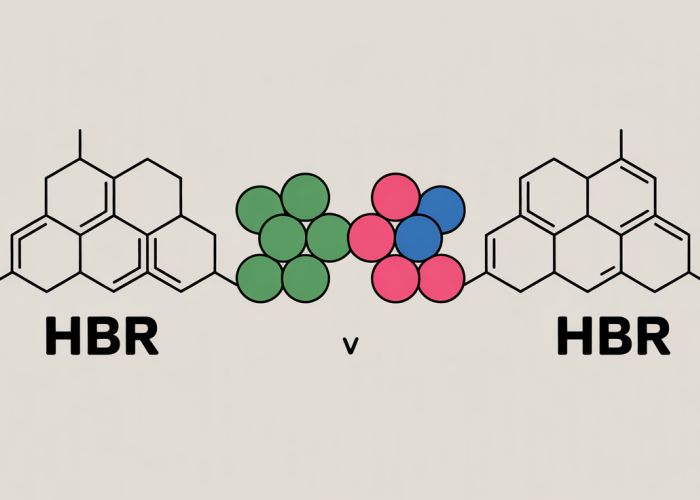Hydrogen bromide (HBr), a diatomic molecule, exhibits properties that prompt the fundamental question: hbr covalent or ionic? The electronegativity difference between hydrogen and bromine, a key concept in chemical bonding, influences its molecular behavior. Consider Linus Pauling’s electronegativity scale; it provides a framework for predicting the type of bond formed. Practical applications within pharmaceutical chemistry often rely on understanding HBr’s bonding nature for designing effective drug molecules.

Deconstructing HBr: A Guide to Understanding its Bonding
This guide aims to dissect the nature of the chemical bond within hydrogen bromide (HBr) to determine if it’s primarily covalent or ionic. We will analyze the factors that influence bond type and apply them specifically to HBr.
Defining Covalent and Ionic Bonds
First, let’s establish a clear understanding of what defines covalent and ionic bonds.
- Covalent Bonds: Formed through the sharing of electrons between atoms. This typically occurs when the electronegativity difference between the bonding atoms is small. Covalent compounds often exist as discrete molecules.
- Ionic Bonds: Formed through the transfer of electrons from one atom to another, creating ions (charged particles). This usually happens when there’s a significant difference in electronegativity between the atoms. The resulting ions are held together by electrostatic attraction. Ionic compounds typically form crystal lattices rather than discrete molecules.
Examining the Electronegativity Difference in HBr
Electronegativity Values
The electronegativity of an element is a measure of its ability to attract electrons in a chemical bond. We need the electronegativity values for hydrogen (H) and bromine (Br) to understand HBr’s bonding.
- Hydrogen (H): Approximately 2.20
- Bromine (Br): Approximately 2.96
Calculating the Difference
The electronegativity difference (ΔEN) is calculated by subtracting the smaller electronegativity value from the larger one. In this case:
ΔEN = |2.96 – 2.20| = 0.76
Interpreting the Electronegativity Difference
The electronegativity difference provides an indication of the bond’s polarity and type.
| Electronegativity Difference (ΔEN) | Bond Type Indication |
|---|---|
| 0 – 0.4 | Nonpolar Covalent |
| 0.4 – 1.7 | Polar Covalent |
| > 1.7 | Primarily Ionic |
Based on the calculated ΔEN of 0.76, the bond in HBr falls within the range indicative of a polar covalent bond.
Polarity in HBr
Unequal Electron Sharing
The electronegativity difference shows that bromine is more electronegative than hydrogen. This means bromine attracts the shared electrons in the H-Br bond more strongly than hydrogen does.
Resulting Partial Charges
Because bromine attracts the electron density more effectively, it acquires a partial negative charge (δ-), while hydrogen acquires a partial positive charge (δ+). This creates a dipole moment within the molecule. We can represent this as:
δ+H – Brδ-
Other Supporting Evidence
Physical Properties
The physical properties of HBr, such as its relatively low boiling point (-67 °C), align more closely with covalent compounds than with ionic compounds, which typically have very high melting and boiling points. Ionic compounds are typically solids at room temperature, while HBr is a gas.
Conductivity
Ionic compounds conduct electricity when dissolved in water (or in the molten state) because the ions are free to move and carry charge. HBr, in its pure gaseous state, does not conduct electricity. Although HBr can ionize in water to form hydronium (H3O+) and bromide (Br-) ions, it only conducts electricity after it has reacted with water. This behavior is different from that of many classic ionic compounds like NaCl, which readily dissociate in water.
HBr Bonding FAQs: Covalent or Ionic?
Here are some frequently asked questions to further clarify the nature of bonding in HBr.
Is HBr always a covalent compound?
No, while HBr is predominantly covalent in its gaseous and liquid states, its behavior can become more complex in solution. When dissolved in water, HBr acts as a strong acid, ionizing to form H+ and Br- ions. This doesn’t change the inherent nature of the HBr molecule itself.
Why is HBr considered covalent if it can form ions?
The primary reason HBr is considered covalent is due to the sharing of electrons between hydrogen and bromine. The electronegativity difference between H and Br isn’t large enough to completely transfer electrons, resulting in a covalent bond. Ion formation occurs when HBr reacts with water, not in isolation.
How does electronegativity determine if HBr is covalent or ionic?
Electronegativity is key. The electronegativity difference between hydrogen and bromine is relatively small. A large electronegativity difference (typically greater than 1.7) suggests an ionic bond. In HBr, the smaller difference confirms its covalent nature.
So, is "HBr covalent or ionic" a trick question?
Not necessarily a trick question, but it requires nuance. In its pure molecular form, HBr is considered a covalent compound. However, the question prompts consideration of HBr’s behavior in different contexts, particularly its acidic nature in aqueous solutions. HBr bonds covalently but readily dissociates into ions in water.
So, did you nail down whether hbr covalent or ionic? Hopefully, this guide cleared things up! Now go forth and bond like a pro!



